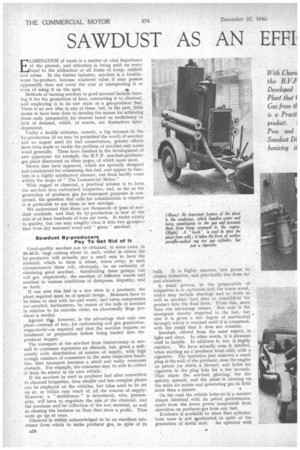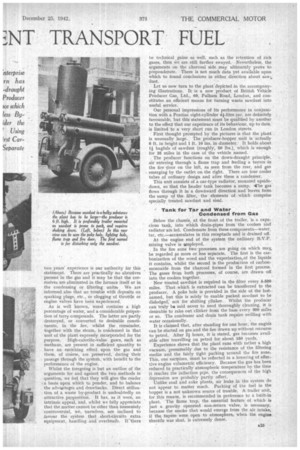SAWDUST AS AN EFFI
Page 26

Page 27

If you've noticed an error in this article please click here to report it so we can fix it.
-7sNT TRANSPORT FUEL ELIMINATION of waste is a matter of vital importance at the present, and attention is being paid on every
hand to the utilization of all forms of scrap, rubbish and refuse. In the timber industry, sawdust is a troublesome by-product, because whatever value it may possess apparently does not cover the cost of transporting it or even of using it on the spot. ass
Methods of turning sawdust to good account-Include burning it for the generation of heat, converting it to charcoal,
and employing it in its raw state as a gas-producer fuel. There is no new idea in any of these, but, in the past, little seems to have been done to develop the means for achieving these ends, presumably for reasons based on inefficiency or lack of demand, which, of course, are themselves interdependent.
Under a double stimulus, namely, a big increase in the by-production (if we may be permitted-the word) of sawdust and an urgent need for fuel conservation, greater efforts have been made to tackle the problem of sawdust and waste wood generally. These have resulted in the development of new apparatus: for exarhple, the B.V.P. sawdust-producergas plant illustrated on these pages, of which more anon.
Stoves also have appeared, which are specially designed and constructed for consuming this fuel, and appear to function in a highly satisfactory manner, but these hardly come within the scope of "The Commercial Motor."
With regard to charcoal, a practical scheme is to_ form the sawdust into carbonized briquettes, and, so far as the generation of producer gas for -transport purposes is concerned, the question that calls for consideration is whether it is preferable to use these or raw sawdast. .
We understand that there ale thousands of tons of sawdust available, and that its by-production is now at the
rate of at least hundreds of tons per week. It varies widely in quality, but one may roughly class it into two groups— that from dry seasoned wood and " green " sawdust.
Sawdust By-producers Pay To Get Rid of It Good-quality sawdust can be obtained, in some cases, in 30-40-lb. bags costing about Is. each, whilst in others the by-producers will actually pay a small sum to have the material, which to them is refuse, taken away; in such 'circumstances' there will, obviously, be no certainty of obtaining good sawdust. Subdividing these groups, ene will get, respectively, the sawdust of different woods and sawdust in various conditions of dampness, impurity, and so forth, If one uses this fuel in a raw state in a producer, the plant required must be of special design. Measures have to be taken to deal with tar and water, and 'extra components are entailed, furthermore, by reason of the bulk of sawdust in relation to its calorific value, an abnormally Urge producer is needed.
Against thys, however, is the advantage that only one plant—instead of two, for carbonizing and gas generation, respectively—is required and that the sawdust requires no treatment or preparation before being loaded into the producer hopper.
The transport of the sawdust from timber-camp or sawmill to consumer represents an obstacle, but, given a sufficiently wide distribution of sources of supply, with high enough numbers of consumers in the same respective localities, then transport becomes a small and easily overcome obstacle. For example, the consumer may be able to collect it from its sourcein his own vehicle. '
If the sawdust be used as producer fuel after conversion charcoal briquettes, then smaller and less complex plants can be employed on the vehicles, but kilns need to be set up at, or within easy reach of, all the sources of supply.
Moreover, a " middleman " is introduced, who, presumably, will have to negotiate the sale of the charcoal, and the purchase andlor collection of the raw, material, as well as running the business on lines that show a profit. Thus costs go up at once.
Charcoal is widely acknowledged to be an excellent substance from which to make producer gas, in spite of its
.bulk. It is highly reactive, :not prone to clinker formation, and practically free from tar and abrasives.
A usual process in the preparation of briquettes is to carbonize first the waste wood, which may include shavings and so forth as well as sawdust/and then to consolidate' the product into the final form. From this, more than one advantage ensues. Not only is the maximum density imparted to the fuel,. but also it is given a fair degree of mechanical ttrength which is retained until it is consumed, with the result that it does not crumble.
Sawdust, viewed from the same aspect., is light and clean. In other words, it is pleasant stuff to,handle. In addition it, too, is highly reactive. We have actually seen it kindled, when starting up a-producer froth cold, with a cigarette. The operative just removes a small plug in the wall of the producer, runs the engine on petrol (or statts , a blower) and holds his cigarette in the plug hole for a few seconds. That starts the sawdust glowing; the fire quickly spreads, and the plant is running on the main air intake and generating gas in little
more than a minute. • On the road the vehicle behaves in a manner almpst identical with its petrol performance. apart from the lower power inseparable from operation on producer-gas from any fuel.
Evidence is available to show that cylinderbore wear is not qc,celerateel, in spite of the generation of acetic acid. An operator with two years' experience is our authority for this statement. There are practically no abrasives present in the gas and it may be that the corrosives are eliminated in the furnace itself or in the condensing or filtering unitst We are informed also that no trouble with deposits on sparking plugs, etc., or clogging of throttle or engine valves have been experienced.
As is well known, wood contains a high percentage of water, and a considerable proportion of tarry compounds. The latter are partly destroyed. or converted to desirable constituents, in the fire, whilst the remainder, together with the steam, is condensed in that unit of the plant expressly incorporated for the purpose. High-calorific-value gases, such as methane, are present in sufficient quantity to have an enriching effect upon the gas and these, of course, are preserved, during their passage through the system, with benefit to the performance of the engine.
Whilst the foregoing is but an outline of the arguments for and against the two methods in question, we feel that they will give the reader a basis upon which to ponder, and to balance the advantages and drawbacks. Direct utilization of a waste by-product is undoubtedly an attractive proposition. It has, as it were, an intrinsic appeal, and, whilst we fully appreciate that the matter cannot be other than immensely 'controversial, we, 'ourselves, are inclined to favour the system that short-circuits extra equipment, handling and overheads. If 'there
be technical gains as well, such as the retention of rich gases, then we are still further swayed. Nevertheless, the arguments on the charcoal side may ultimately prove to preponderate. There is not much data yet available upon which to found conclusions in either direction about saw7., "dust.
Let us now turn to the plant depicted in the accompanying illustrations. It is a new product of British Vehicle Producer Gas, Ltd., 69, Fulham Road, London, and constitutes an efficient means for turning waste sawdust into useful service.
Our personal impressions of its performance in conjunction with a Pontiac eight-cylinder 41-litre car, are definitely favourable, but this statement must be qualified by another to the effect that our experience of its behaviour, up to date, is limited to a very short run in London streets.
First thought prompted by the pictures is that the plant is unusually large. The producer-hopper unit is 'actually 6 ft. in height and 1 ft. 10 ins, in diameter.' It holds about 11 bagfuls of sawdust (roughly, 50 lbs.), which is enough for 35 miles in the case of the vehicle named.
The producer functions on the down-draught principle, air entering through a flame trap and feeding a tuyere in the fire -Floor on the left, as seen from the rear, and gas emerging by the outlet on the right. There are four cooler tubes of ordinary design and after these a condenser.
This unit consists of a car-type radiator, mounted upsidedown, so that the header tank becomes a sump. ''he gas flows through it in a downward direction and leaves from the sump of the filter, the elements of which comprise specially treated sawdust and sisal.
Tank for Tar and Water • Condensed from Gas
Below the chassis., at the front of the trailer, is a capacious tank, into which drain-pipes from the coolers and
radiator are led. Condensate from these components—water, tar, etc.—accumulates in this receptacle and is drained off. At the engine end of the system the ordinary B.V.P. mixing valve is employed. In the fire zone two' processesare going on which may, be regarded as more or less separate. The first is the carbonization of the wood and the vaporization,of the liquids it contains, whilst the second is the production of carbonmonoxide from the charcoal formed in the first process. The gases from both processes, of course, are drawn off into the coolers together. New treated sawdust is required in the filter every 4-500 miles. That which is extracted can be transferred to the producer. A poke hole is provided in the side of the last- named, but this is solely to enable packed sawdust to be dislodged: not for shifting clinker. Whilst the producer can truly be said never to need thoroughly cleaning, it is desirable to rake out clinker from the base every 300 Miles or so. The condenser and drain tank require swilling with water occasionally. It is claimed that, after standing for one hour, the engine can be started on gas and the fire drawn up without recourse to petrol. After 2-/ hours, it is stated, gas becomes available after travelling on petrol for about 150 yards,
Experience shows that the plantruns with rather a high vacuum, presumably due to the resistance of the filtering
medim and the fairly tight packing around the fire zone,
This, one surcnizes, must bereflected in a lowering of effective engine volumetric efficiency. Because the gas has been
reduced to practically atmospheric temperature by the time it reaches the induction pipe, the consequences of the high depression are probably partly offset, Unlike coal and coke plants, air leaks in the system do not appear to matter much. Packing of the fuel in the
hopper is a not unknown source of trouble. A trailer unit, for this reason, is recommended in preference to a built-in plant. The flame trap, the essential feature of which is just a gravity operated non-return valve, is necessary, because the smoke that would emerge from the air intake, if the tuyere were open to atmosphere., when the engine throttle was shut, is extremely dense.




















































